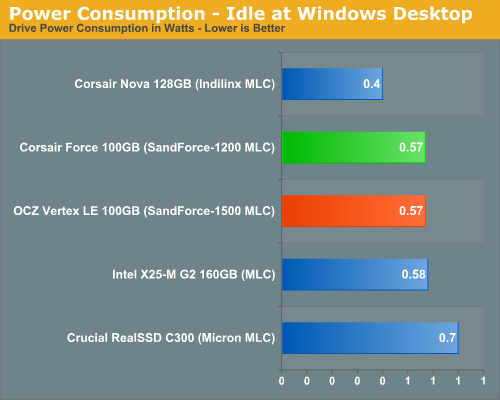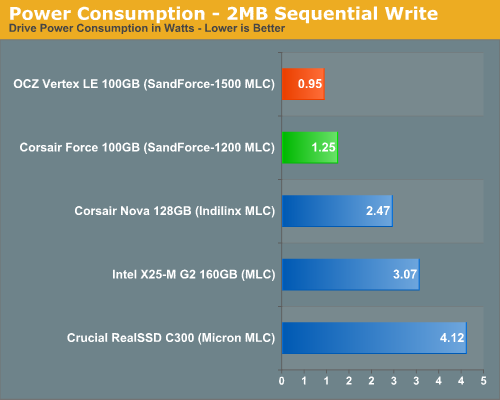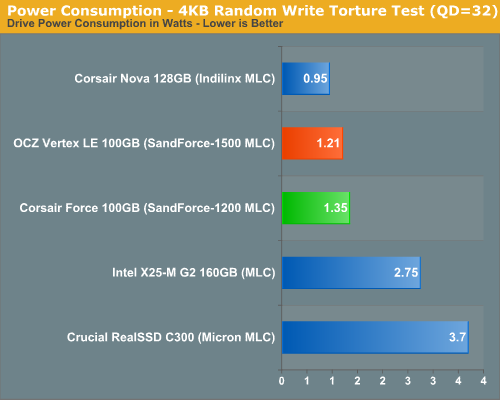Corsair's Force SSD Reviewed: SF-1200 is Very Good
by Anand Lal Shimpi on April 14, 2010 2:27 AM ESTPower - A Telling Story
I'm quietly expanding our SSD test suite. I haven't made the results public but you'll see them in the coming months appear in articles and in Bench. One of my tests happens to be a power consumption test where I measure how much power the drive itself requires during a few scenarios. The results with the SandForce SSDs in particular were fascinating enough for me to unveil some of these numbers a bit earlier than I'd originally planned.
In an SSD you have two main consumers of power: the controller, any external DRAM and the NAND. Now as long as you're not bound by the speed of the controller, the biggest consumer of power should be the NAND itself. Now here's where things get interesting. SandForce's DuraWrite technology should mean that there's far less writing to NAND going on in the Corsair Force drive compared to more conventional SSDs. Unless the controller consumes an absurd amount of power, we should see this reflected in the power numbers.
Note that I am not running with Device Initiated Power Management enabled, which is disabled by default in desktop installations of Windows. Power consumption in a notebook will be lower on drives that support it but I'll save that for another article.

At idle the two SF drives and Intel's X25-M G2 consume roughly the same power. Crucial's C300 is a bit more power hungry while the Indilinx based Nova is noticeably lower.

The highest power draw scenario is a sequential write test. The NAND is being written to as quickly as possible and thus power consumption is at its highest. Here we have proven our hypothesis. The SandForce drives are writing less than the competition and thus their power consumption is less than half of the Intel and Crucial drives. Based on the power numbers alone I'd say that SandForce's compression is working extremely well in this test possibly only writing about half as much data to the NAND itself. In practice this means the controller has less to track, the NAND has a longer lifespan and performance is very competitive.

In our random write test, the power gap between the SF and Intel drives narrows but not tremendously. The Indilinx drive actually beats out the SF offerings but I have a feeling that's because we're actually more controller bound here and the data just isn't getting out to NAND.
Another curious observation is the fact that the SF-1200 based Corsair Force actually draws more power than OCZ's Vertex LE. It's not noticeable in real world desktop use, but it's odd. I wonder if the SF-1200s are really just higher yielding/lower binned SF-1500s? Perhaps they draw more power as a result?
The Test
| CPU | Intel Core i7 965 running at 3.2GHz (Turbo & EIST Disabled) |
| Motherboard: | Intel DX58SO (Intel X58) |
| Chipset: | Intel X58 + Marvell SATA 6Gbps PCIe |
| Chipset Drivers: | Intel 9.1.1.1015 + Intel IMSM 8.9 |
| Memory: | Qimonda DDR3-1333 4 x 1GB (7-7-7-20) |
| Video Card: | eVGA GeForce GTX 285 |
| Video Drivers: | NVIDIA ForceWare 190.38 64-bit |
| Desktop Resolution: | 1920 x 1200 |
| OS: | Windows 7 x64 |










63 Comments
View All Comments
JohnQ118 - Thursday, April 15, 2010 - link
Just in case if you are using IE8 - open the Print view; then simply from the View menu select Style - No Style.You will get some small margins. Then adjust the window size as comfortable for reading.
remosito - Wednesday, April 14, 2010 - link
Hi there,thanks for the great review. I couldn't find from the article what kind of data you are writing
for the random 4k read/write tests. Those random write numbers look stellar.
Which might have to do with the data being written being not very random at all and allowing for big gain coming from the sandforce voodoo/magicsauce/compression???
Mr Alpha - Wednesday, April 14, 2010 - link
I believe the build of IOMeter he uses writes randomized data.shawkie - Wednesday, April 14, 2010 - link
This is a very important question - nobody is interested in how quickly they can write zeroes to their drive. If these benchmarks are really writing completely random data (which by definition cannot be compressed at all) then where does all this performance come from? It seems to me that we have a serious problem benchmarking this drive. If the bandwidth of the NAND were the only limiting factor (rather than the SATA interface or the processing power of the controller) then the speed of this drive should be anything from roughly the same as a similar competitor (for completely random data) to maybe 100x faster (for zeroes). So to get any kind of useful number you have to decide exactly what type of data you are going to use (which makes it all a bit subjective). In fact, there's another consideration. Note that the spare NAND capacity made available by the compression is not available to the user. That means the controller is probably using it to augment the reserved NAND. This means that a drive that has been "dirtied" with lots of nice compressable data will perform as though it has a massive amount of reserved NAND whereas a drive that has been "dirtied" with lots of random data will perform much worse.nafhan - Wednesday, April 14, 2010 - link
My understanding is that completely random and uncompressible are not the same thing. An uncompressible data set would need to be small and carefully constructed to avoid repetition. A random data set by definition is random, and therefore almost certain to contain repetitions over a large enough data set.jagerman42 - Wednesday, April 14, 2010 - link
No; given a random sequence of 0/1 bits with equal probability of each, the expected number of bits to encode the stream (i.e. on average--you could, through extremely unlikely outcome, have a compressible random sequence: e.g. a stream of 1 million 0's is highly compressible, but also extremely unlikely, at 2^(-1,000,000) probability of occurrence).So onwards to the entropy bits required calculation: H = -0.5*log2(0.5) -0.5*log2(0.5) = -0.5*(-1) -0.5*(-1) = 1.
In other words, a random, equal-probability stream of bits can't be compressed at a rate better than 1 bit per bit.
Of course, this only holds for an infinite, continuous stream; as you shorten the length of the data, the probability of the data being compressible increases, at least slightly--but even 1KB is 8192 bits, so compressibility is *hard*.
Just for example's sake, I generated a few (10 bytes to 10MB) random data files, and compressed using gzip and bzip2: in every case (I repeated several times) the compressed version ended up larger than the original.
For more info on this (it's called the Shannon theory, I believe, or also "Shannon entropy" according to the following), see: http://en.wikipedia.org/wiki/Entropy_(information_...
shawkie - Wednesday, April 14, 2010 - link
I'm also not convinced by the way Anand has arrived at a compression factor of 2:1 based on the power consumption. The specification for the controller and Anand's own measurements show that about 0.57W of power is being used just by the controller. That only leaves 0.68W for writing data to NAND. Compare that with 2.49W for the Intel drive and you end up with a compression factor of more like 4:1. But actually this calculation is still a long way out because 2MB/s sequential writes are 250MB/s on the SandForce and only 100MB/s on the Intel. So we've written 2.5x as much (uncompressed) data using 1/4 as much NAND power consumption. So the compression factor is actually more like 10:1. I think that pretty much proves we're dealing with very highly compressable data.HammerDB - Wednesday, April 14, 2010 - link
That should definitely be checked, as this is the first drive where different kinds of data will perform differently. Due to the extremely high aligned random write performance, I suspect that the data written is either compressible or repeated, so the drive manages to either compress or deduplicate to a large degree.One other point regarding the IOMeter tests: the random reads perform almost identical to the unaligned random writes. Would it be possible to test both unaligned and aligned random reads, in order to find out if the drive is also capable of faster random reads under specific circumstances?
Anand Lal Shimpi - Wednesday, April 14, 2010 - link
Correct. The June 08 RC build of Iometer uses randomized data. Older versions used 0s.Take care,
Anand
shawkie - Wednesday, April 14, 2010 - link
Anand, do you therefore have any explanation for why the SandForce controller is apparently about 10x more efficient than the Intel one even on random (incompressible) data? Or can you see a mistake in my analysis?